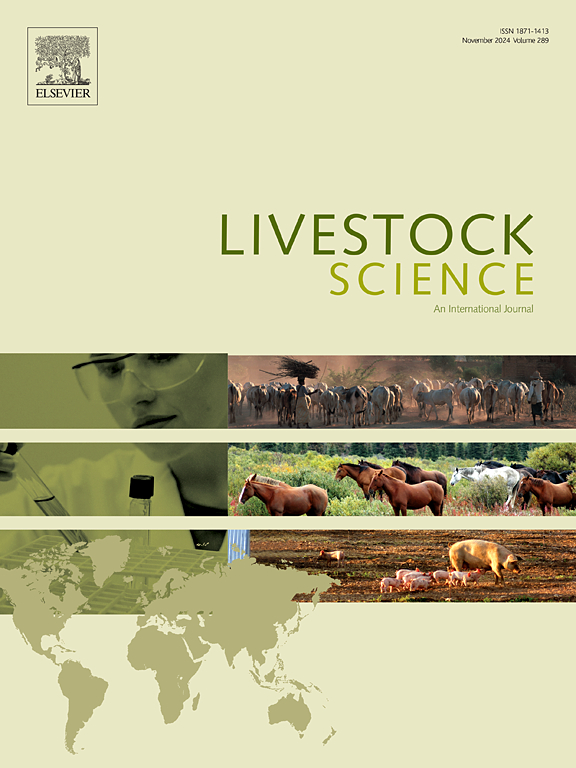Milk somatic cell count and its relationship with feed efficiency, and with GreenFeed-estimated methane emission and energy partitioning variables in Nordic Red cows
IF 1.9
3区 农林科学
Q2 AGRICULTURE, DAIRY & ANIMAL SCIENCE
引用次数: 0
Abstract
The objective of this study was to evaluate the relationship of somatic cell count (SCC) with production efficiency, energy partitioning, and methane emission in Nordic Red cows. Data were obtained from 10 previously conducted experiments consisting of 3 milk production trials and 7 GreenFeed (GF) studies, with available information on SCC, body weight (BW), milk production and feed intake. The complete data set consisted of a total of 924 cow/period observations from 265 cows. A subset of 150 cow/period observations from three of the GF studies, with available data on digestibility, and heat production were used for analysing energy partitioning variables. All measurements were made on cows fed diets based on grass silage with a range of protein and energy supplements. Production efficiency and energy partitioning variables were evaluated by mixed-model regression in SAS (SAS Institute Inc., Cary, NC). with the natural logarithm of SCC (lnSCC) treated as a fixed variable. Experiment (Exp), diet(Exp), and period(Exp) were included as random effects, allowing their effects to be excluded from the fixed-effect estimates. Additionally, segmented regression (PROC NLMIXED in SAS) was applied to determine SCC thresholds affecting feed efficiency variables. An increase in lnSCC showed a negative relationship with milk lactose concentration, milk yield, energy corrected milk (ECM), residual ECM, and feed conversion efficiency. Conversely, milk protein concentration increased with rising lnSCC. A trend towards increased BW was noted with rising lnSCC. Methane energy intensity and heat production increased while the efficiency of metabolizable energy (ME) use for lactation (kl) decreased with elevated lnSCC. We identified SCC thresholds of 40 000 cells/mL for heat production (HP) and 74 000 cells/mL for kl, indicating that HP increases at an earlier stage of infection, while a more advanced infection is required to impair energy utilization efficiency. These findings underscore the importance of early SCC management to sustain production, minimize energy losses, and enhance feed efficiency and overall dairy sustainability.
北欧红牛的牛奶体细胞数及其与饲料效率、GreenFeed 估算的甲烷排放量和能量分配变量的关系
本研究旨在探讨北欧红牛体细胞计数与生产效率、能量分配和甲烷排放的关系。数据来自先前进行的10项试验,包括3项产奶量试验和7项绿色饲料(GF)研究,其中包括SCC、体重(BW)、产奶量和采食量的现有信息。完整的数据集包括265头奶牛的924头/期观测数据。从三个GF研究中获得的150头奶牛/周期的观察数据,以及消化率和产热的可用数据,用于分析能量分配变量。所有的测量都是在饲喂以草青贮饲料为基础的奶牛上进行的,并添加了一系列蛋白质和能量补充剂。采用SAS (SAS Institute Inc., Cary, NC)的混合模型回归评估生产效率和能量分配变量。以SCC的自然对数(lnSCC)作为固定变量。试验(Exp)、饮食(Exp)和时期(Exp)被纳入随机效应,使其效应不受固定效应估计的影响。此外,采用分段回归(SAS中的PROC NLMIXED)来确定影响饲料效率变量的SCC阈值。lnSCC的增加与乳糖浓度、产奶量、能量修正乳(ECM)、剩余ECM和饲料转化率呈负相关。相反,乳蛋白浓度随lnSCC的升高而升高。随着lnSCC的增加,体重有增加的趋势。随着lnSCC升高,奶牛的甲烷能强度和产热增加,泌乳代谢能(ME)利用效率降低。我们确定了产热(HP)的SCC阈值为40000细胞/mL, kl的SCC阈值为74000细胞/mL,这表明HP在感染的早期阶段增加,而更晚期的感染需要损害能量利用效率。这些发现强调了早期SCC管理对于维持生产、减少能量损失、提高饲料效率和整体乳制品可持续性的重要性。
本文章由计算机程序翻译,如有差异,请以英文原文为准。
求助全文
约1分钟内获得全文
求助全文
来源期刊

Livestock Science
农林科学-奶制品与动物科学
CiteScore
4.30
自引率
5.60%
发文量
237
审稿时长
3 months
期刊介绍:
Livestock Science promotes the sound development of the livestock sector by publishing original, peer-reviewed research and review articles covering all aspects of this broad field. The journal welcomes submissions on the avant-garde areas of animal genetics, breeding, growth, reproduction, nutrition, physiology, and behaviour in addition to genetic resources, welfare, ethics, health, management and production systems. The high-quality content of this journal reflects the truly international nature of this broad area of research.
 求助内容:
求助内容: 应助结果提醒方式:
应助结果提醒方式:


